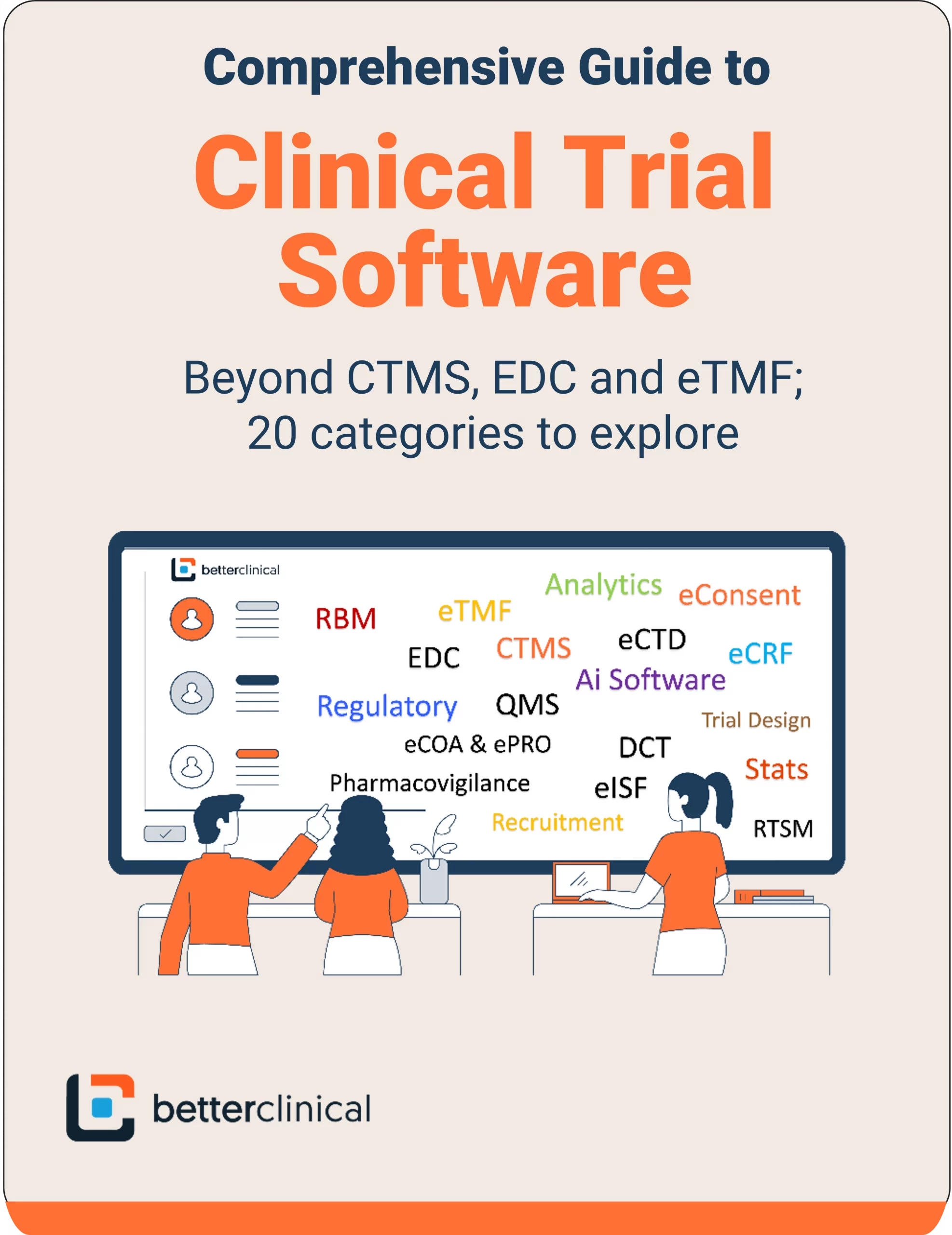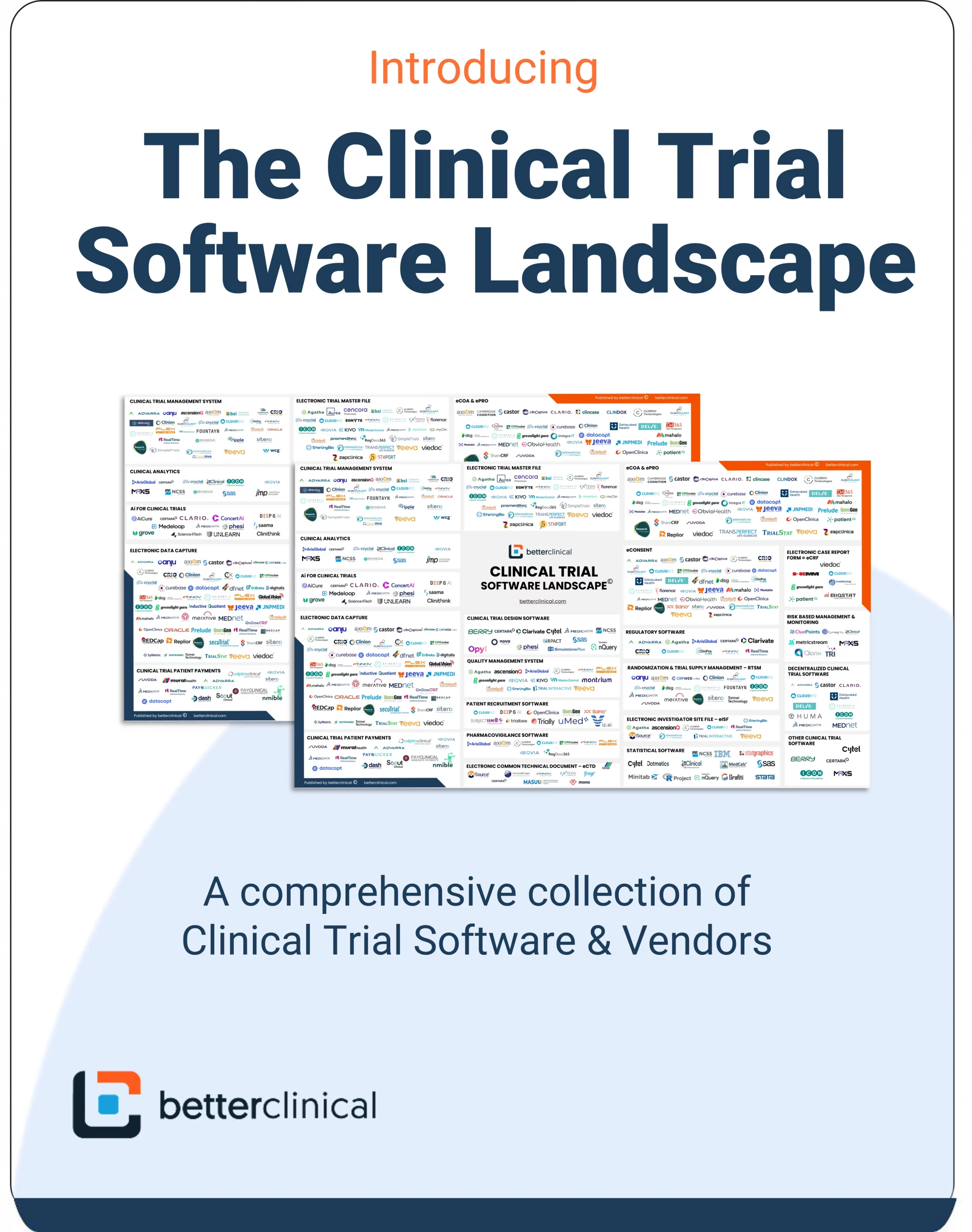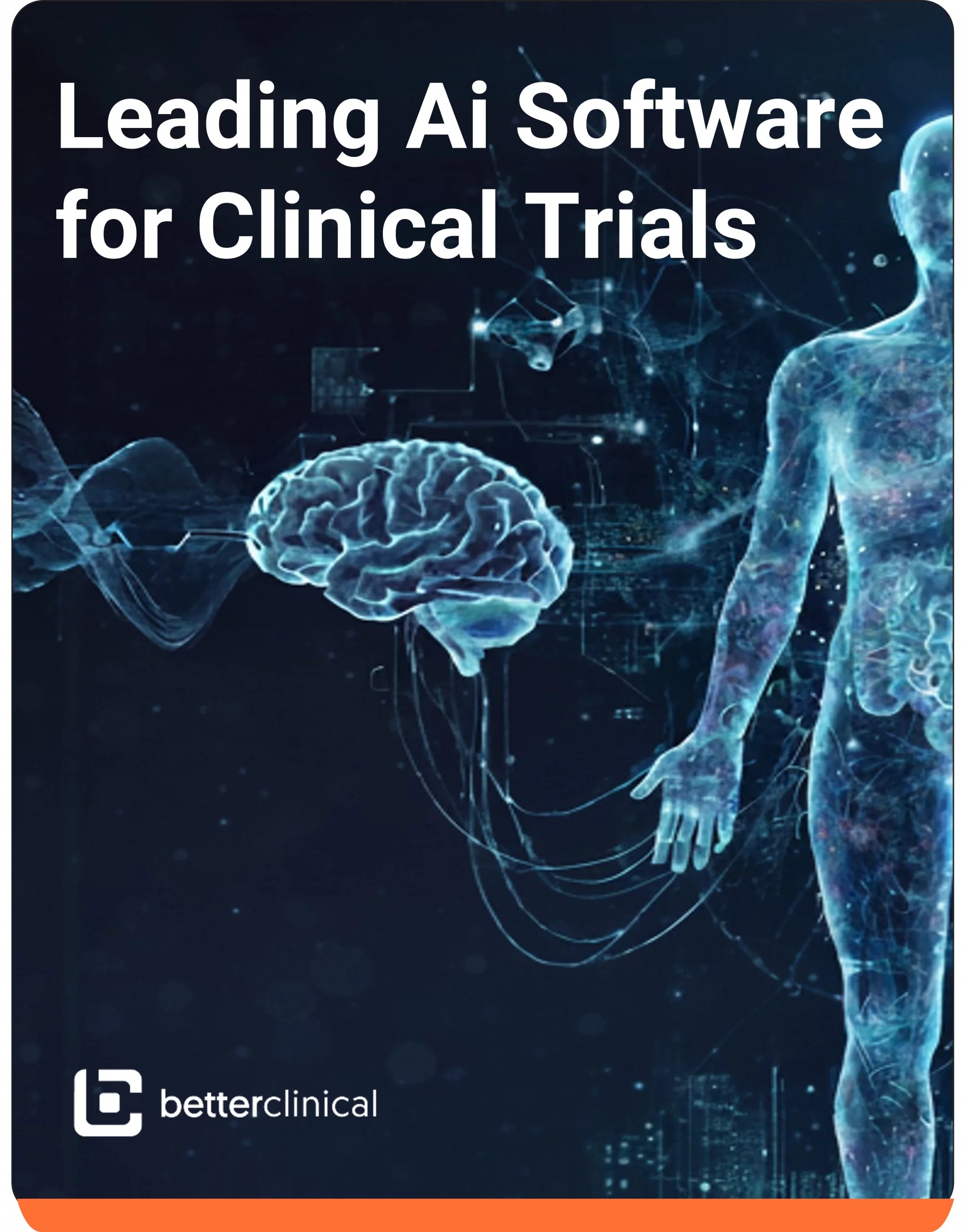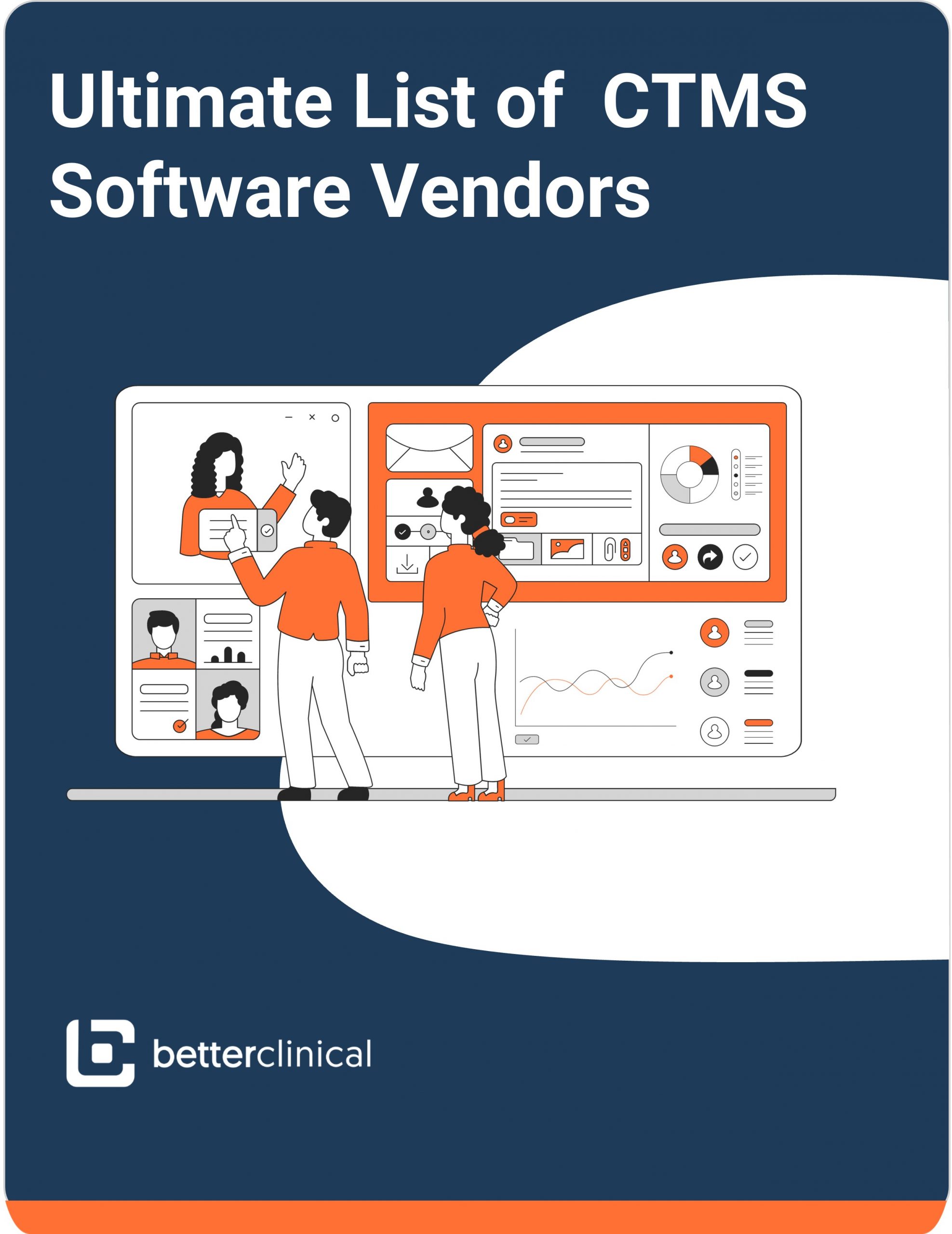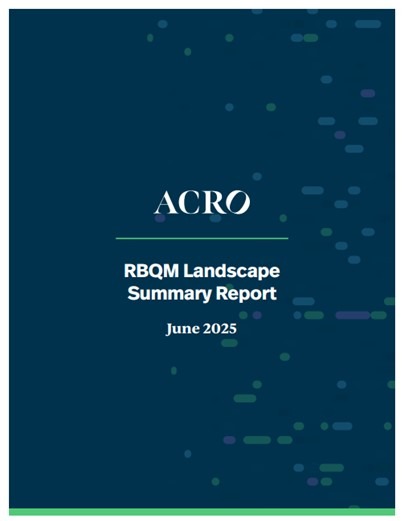Key Takeaways
TL;DR
Many teams still equate “clinical trial software” with CTMS, EDC, or eTMF. However, modern studies benefit from a broader set of software tools that reduce manual work, improve data quality, strengthen inspection readiness, and help studies finish faster with fewer surprises.
This guide maps 20 distinct categories of clinical trial software and links to vendor directories so sponsors, CROs, and sites can review vendor options that are available.
Categories showcased include CTMS, EDC, eTMF, AI Software for Clinical Trials, Regulatory Software, RTSM/IRT, eConsent, eCOA & ePRO, Clinical Analytics, Decentralized Clinical Trial Software, Patient Recruitment Software, Quality Management System, Pharmacovigilance Software, eISF, Clinical Trial Design Software, eCRF, RBM/RBQM, eCTD, Statistical Analysis Software and Patient Payments.
Table of Contents
Introduction
“Clinical trial software” is often shorthand for the big three: CTMS (operations), EDC (data capture), and eTMF (documents). In practice, today’s trials run on a much wider stack. Alongside those pillars are tools for eConsent and eCOA/ePRO, randomization and supply (RTSM/IRT), risk-based quality (RBQM), eSource and EHR connectivity, decentralized participation, analytics and AI, site enablement (eISF, payments, start-up), safety/pharmacovigilance, regulatory/eCTD, quality management, protocol and eCRF design, and interoperability hubs that connect the ecosystem. This broader landscape reduces manual work, improves data accuracy, speeds enrollment and monitoring, and keeps studies inspection-ready.
Below, we map 20 clinical trial software categories so sponsors, CROs, and sites can see what’s available beyond the familiar trio and access vendor lists to strengthen their next study.
What is Clinical Trial Software?
The short answer
Clinical trial software helps researchers plan, run, monitor, and finish a clinical study in a way that is safe for participants, trustworthy for regulators, and efficient for sponsors and sites. It replaces fragile, manual steps like emails, spreadsheets or paper binders with structured, auditable workflows so clinical trial science holds up and timelines don’t slip.
The longer answer
1) A trial is a giant “evidence machine”
A clinical trial is a controlled way to answer a medical question “Does this treatment work and is it safe?”. To convince regulators, payers, clinicians, and patients, you need evidence that is:
- Accurate (what you recorded matches what really happened),
- Complete (nothing important is missing),
- Traceable (you can show who did what, when, and why),
- Consistent (data is structured the same way across patients and sites),
- Secure (only authorized people can access or change it).
Clinical trial software is built to enforce these qualities from start to finish….hopefully.
2) Why clinical trial software exists
- Trials are complex and distributed. Dozens of sites, hundreds of people, thousands of tasks. Software coordinates who does what, when, and how.
- Manual work breaks. Copy-pasting between spreadsheets and emails creates delays, errors and extra costs. Software automates handoffs and keeps a single source of truth.
- Mistakes are expensive. A missing consent version or a mislabeled dataset can cost months. Software builds guardrails like version control, validations, audit trails.
- Regulatory proof matters. You must show how data was created, changed, approved, and stored, not just say so. Software keeps that proof automatically.
- Participants deserve better. Modern tools simplify consent, reminders, and at-home data collection, reducing friction and travel.
- Data volume exploding. Devices, images, labs, and e-forms produce far more data than paper processes can handle reliably. Software structures and standardizes it.
- Timelines and budgets are tight. Automation, dashboards, and integrated workflows hopefully help teams execute on time and on budget.
3) Who uses clinical trial software and why
- Sponsors & biotech teams: plan studies, oversee quality, manage vendors, compile submissions.
- CROs (contract research organizations): run day-to-day operations for sponsors and ensure consistent processes across studies.
- Sites (hospitals/clinics): enroll participants, collect data, document what happened, and get paid on time.
- Monitors & auditors: verify data and processes, track issues, and confirm corrective actions.
- Regulatory and safety teams: maintain compliant records and handle adverse event workflows.
Each group sees a tailored view, but they are all looking at the same live truth.
4) Features, Advantages & Benefits of software for clinical trials
- Integrity by default: audit trails, access controls, and validations mean the record can be trusted without detective work.
- Less rework: standards-aligned data and consistent forms reduce last-minute fixes before database lock or submission.
- Speed with control: automated tasks, templates, and integrations get work done faster without losing oversight.
- Participant-friendly: digital consent, reminders, and device data make participation easier and reduce missed information.
- Fewer surprises at inspection: well-organized documents and traceable decisions lower anxiety and effort when regulators review your trial.
- Clear visibility: dashboards let leaders spot roadblocks early and redirect resources before timelines slip.
- Reusable muscle: once a team sets up forms, templates, and integrations, the next study can start faster and cheaper.
5) What clinical trial software is not
- It is not a magic button that makes bad study design good. Solid protocols still matter.
- It is not a replacement for training. People need to know why a new process helps them.
- It is not one monolithic system. It is a stack of tools that should be thoughtfully connected.
More Clinical Trial Software categories than you realize – 19 categories to review
While CTMS, EDC, and eTMF are the backbone of many trials, they don’t cover everything modern studies need. Today’s operations also rely on tools that make participation easier (eConsent and eCOA/ePRO), prevent supply and blinding mistakes (RTSM/IRT), pull data directly from clinics and devices to cut errors (eSource, EHR and wearable integrations), focus oversight where risk is highest (RBQM), speed site start-up and payments, manage safety cases, and turn raw signals into clear decisions (analytics and dashboards).
On top of that, AI software for clinical trials is now dramatically improving clinical data analysis by automating data cleaning, spotting anomalies in near-real time, predicting enrollment and drop-off risks, flagging protocol deviations, matching patients to studies, and extracting insights from unstructured text (notes, PDFs, imaging reports). Looking beyond the “big three” to the full range of available applications, including AI, reduces manual work, improves data quality, strengthens inspection readiness, and ultimately helps studies finish faster with fewer surprises.
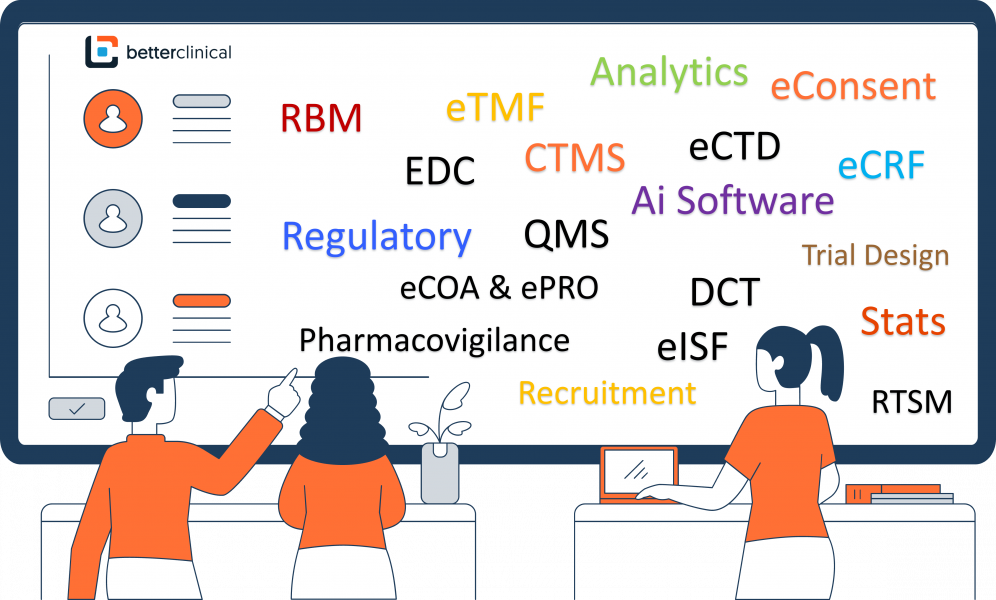
List of Clinical Trial Software Categories
What follows is a summary of 20 specific clinical trial software categories that clinical trial operators can leverage to generate better results. We link each category to its corresponding vendor directory on betterclinical so you can review some of the vendors within each of these categories.
Let’s start with the big three:
Clinical Trial Management System (CTMS)
Clinical Trial Management System or CTMS is software used to manage clinical trial operations. The operational hub for timelines, tasks, sites, budgets, and reporting, keeps day-to-day work on track and visible.
It is used to centralize trial data, including protocols, patient details, site performance and financial records. It also automates tasks such as scheduling, reporting, document management and provides real-time updates on trial metrics, enabling quick identification of any trial issues.
Benefit: coordinated execution and compliance across teams. While a CTMS enhances collaboration between sponsors, research sites and regulators, it also helps researchers monitor trial progress, manage budgets and maintain compliance with regulatory standards, including Good Clinical Practice guidelines.
Electronic Data Capture (EDC)
EDC software is a web based application used in clinical trials to help collect, manage and store patient data in electronic format. It replaces the previous systems of data collection by means of paper based documents and in this regard it is more efficient and reliable in terms of clinical trial data management. EDC software is used for:
Data collection: Assists researchers to key in data into electronic Case Report Forms (eCRFs) thus enhancing efficiency and decreasing the possibility of errors.
Data validation: It has built in checks for errors and gaps, thus enhancing the quality and completeness of the data.
Real time data access: It enables quick access to trial data this makes it easier to make quick decisions and come up with analyses.
Integration: Some EDC systems can integrate with other clinical trial technologies, which allow for automatic data transfer from different sources.
Data security: It has stronger measures to secure the data collected to ensure that it is not lost, altered or tampered with.
Regulatory and compliance: EDC systems assist in the meet up of the regulatory requirements such as 21 CFR Part 11.
Benefit: higher data quality and quicker decisions, with options to integrate other sources.
Electronic Trial Master File (eTMF)
Electronic Trial Master File (eTMF) software is a structured document management system for essential documents with version control and audit trails for clinical trials. It provides a centralized, secure repository for all trial-related documents and replaces traditional paper-based methods. eTMF software offer researchers a solution for organizing, storing, and accessing critical trial information. Researchers can also instantly share and review documents, track changes through detailed audit trails, and maintain a standardized document structure. This helps meets stringent Good Clinical Practice (GCP) guidelines.
Benefit: inspection-ready documentation and less admin. By automating document workflows, reducing administrative burdens, and minimizing storage costs, eTMF software enables clinical trial teams to focus more on research and less on paperwork.
The above systems matter. However, today’s trials often add other software tools that reduce re-entry, support remote participation, and surface risks earlier.
AI Software for Clinical Trials
AI software for clinical trials uses machine learning to improve how trials are planned, managed, and analyzed. These tools help researchers match patients to studies, design better protocols, monitor progress, and check data for accuracy. They can process large sets of data from electronic health records, wearables, and lab systems. This allows teams to spot trends, predict outcomes, and reduce delays in the trial process. These tools are important because they help save time, lower costs, and improve study quality.
AI can find eligible patients faster, flag issues before they cause problems, and give clear insights into trial performance. Most AI software for clinical trials includes features like predictive analytics, patient recruitment support, risk detection, and automated data review.
Benefit: By using AI, research teams can make better decisions and move treatments to market more quickly, as well as, earlier issue detection, which can save significant time and cost.
Regulatory Software
Regulatory software for clinical trials helps teams manage the planning, submission, and tracking of documents needed for regulatory approval. It organizes regulatory data, deadlines, and correspondence in one system. This includes trial applications, ethics approvals, amendments, and ongoing reporting requirements.
The software supports collaboration between sponsors, sites, and regulatory teams. It tracks submission status, ensures correct document versions, and maintains full audit trails. Many systems include task reminders, compliance checks, and integration with eCTD and eTMF systems. This helps reduce delays and ensures that all regulatory steps are completed on time.
Benefit: fewer deadline misses and clearer regulator communications.
Randomization & Trial Supply Management (RTSM/IRT)
Randomization and Trial Supply Management (RTSM) software is used to manage patient randomization and drug supply in clinical trials. It helps assign treatments based on study protocols and tracks the inventory of investigational products across sites. The software supports both blinded and unblinded trials and ensures that each patient receives the correct treatment.
RTSM systems connect with other trial platforms to monitor enrollment, shipment, and site stock levels in real time. They also manage re-supply, expiration tracking, and drug accountability. This reduces manual errors and keeps the study running without interruptions. RTSM is used by sponsors, CROs, and clinical sites to improve accuracy and efficiency in trial operations.
Benefit: correct assignment and fewer supply gaps.
eConsent Software
eConsent software is used to manage the informed consent process digitally in clinical trials. It allows participants to read, review, and sign consent forms on a tablet, smartphone, or computer. The software includes videos, quizzes, and other tools to help patients understand the study before agreeing to take part. This improves clarity and helps ensure that consent is truly informed.
Researchers use eConsent to track who has signed, when they signed, and whether they understood the key parts of the study. The system stores all records securely and keeps a clear audit trail. It also reduces paperwork and supports faster startup times. eConsent software is widely used in both site-based and decentralized trials.
Benefit: easier participation and complete audit trails across sites.
eCOA & ePRO
eCOA (electronic Clinical Outcome Assessment) and ePRO (electronic Patient-Reported Outcomes) software are digital tools used to collect feedback directly from trial participants. Patients use tablets, smartphones, or web platforms to report symptoms, side effects, and daily health updates. This data helps researchers understand how a treatment affects quality of life, physical function, or emotional well-being.
These tools replace paper forms, reduce errors, and improve data accuracy. They also allow researchers to gather real-time insights from patients without waiting for site visits. eCOA includes ePRO but also covers clinician-reported and observer-reported outcomes. The software ensures that the data meets regulatory standards and is easy to review and analyze.
Benefit: less missing data and more timely outcome capture.
Clinical Analytics
Clinical analytics software helps researchers collect, organize, and study data from clinical trials. It gives teams a clear view of how a trial is performing and where changes may be needed. The software connects to data sources like electronic data capture (EDC) systems, lab results, patient records, and site reports. It turns raw data into charts, summaries, and alerts that are easy to understand and act on.
Clinical analytics supports faster decisions by showing patterns in patient responses, site activity, and protocol performance. It helps spot safety issues, slow enrollment, or missed timelines before they become serious problems. The software also helps sponsors and research teams track key trial indicators, stay compliant, and report results more clearly. Many platforms now include dashboards, predictive models, and visual tools to guide day-to-day trial management.
Benefit: faster decisions and earlier detection of safety or operational issues.
Decentralized Clinical Trial (DCT) Software
Decentralized clinical trial (DCT) software allows studies to run outside of traditional research sites. It supports remote patient participation through mobile apps, telemedicine, and digital data collection tools. The software helps researchers connect with patients in their homes, making trials more flexible and accessible. It also collects data from devices like wearables, home sensors, and online surveys.
DCT software reduces the need for in-person visits and gives patients more control over their participation. This can lead to faster enrollment, better retention, and higher data quality. It also allows trials to reach more diverse populations across different locations. Sponsors and research teams use DCT platforms to track patient activity, schedule virtual visits, and gather real-time health data.
Benefit: more flexible trials, potentially faster enrollment and better retention.
Clinical Trial Patient Recruitment Software
Clinical trial patient recruitment software helps research teams find and enroll eligible participants more efficiently. It uses digital tools to match patient profiles with study requirements based on factors like age, diagnosis, and treatment history. The software often connects to medical records, patient registries, and advertising platforms to reach potential candidates.
Recruitment software tracks each step of the process, from initial outreach to screening and enrollment. It also helps manage communication with patients, send reminders, and collect consent. Some systems include analytics to measure performance and identify where improvements are needed.
Benefit: reduces recruitment delays and helps trials meet enrollment goals quicker, better-qualified enrollment funnels.
Quality Management System (QMS)
Quality Management System (QMS) software for clinical trials helps teams track and control quality-related processes during a study. It supports the management of audits, deviations, corrective actions, training, and document control. The software ensures that trials follow good clinical practice and meet regulatory requirements.
QMS software creates a central platform for logging quality events, assigning tasks, and monitoring timelines. It also stores all quality documents in one secure location with version control and audit trails.
Benefit: reduces manual work and helps research teams respond to quality issues faster.
Pharmacovigilance Software for Clinical Trials
Pharmacovigilance software for clinical trials is used to track and manage safety data related to investigational drugs. It helps research teams collect, review, and report adverse events that occur during a study. The software ensures that safety information is captured accurately and sent to regulators within required timelines.
The system supports case intake, data entry, signal detection, and regulatory reporting. It also includes tools to manage follow-ups, generate narratives, and maintain a clear audit trail.
Benefit: helps sponsors meet safety standards while reducing the risk of delayed reporting or missed events, consistent case handling and timely reporting.
Electronic Investigator Site File (eISF)
Electronic Investigator Site File (eISF) software is used by clinical research sites to manage trial documents in a digital format. It replaces paper binders with a secure online system where all essential documents can be stored, accessed, and updated. Research teams use eISF to manage study logs, approvals, training records, and communication with sponsors.
The software keeps all files organized by study and ensures version control across documents. It also helps users meet regulatory requirements by tracking changes and keeping audit trails. eISF platforms often include features like electronic signatures, document checklists, and real-time collaboration.
Benefit: cleaner site documentation and smoother monitoring.
Clinical Trial Design Software
Clinical trial design software helps teams plan how a study will run before it begins. It guides decisions on patient groups, treatment schedules, endpoints, and data collection methods. The software uses past trial data, simulation tools, and standard templates to reduce errors and create better trial plans. It helps researchers choose clear objectives and define how success will be measured.
The software also allows users to test different trial designs and compare results. This supports faster approvals and improves the chance of success. Trial design software is used by sponsors, contract research organizations (CROs), and academic groups. It helps align all stakeholders and makes sure the plan meets regulatory requirements.
Benefit: fewer mid-study changes and easier analysis later.
Electronic Case Report Form (eCRF) Software
Electronic Case Report Form (eCRF) software is used to collect and manage patient data during clinical trials. It replaces paper forms with digital versions that are easier to fill out, review, and store. Clinical sites enter patient data into eCRFs using web-based platforms. The software then organizes and stores this information in a central database.
eCRF software supports clean and consistent data collection. It includes tools for validation, error checks, and data queries. This helps reduce mistakes and makes sure all required fields are completed. Sponsors, monitors, and data managers can view and manage the data in real time. The system also tracks any changes made to records for full transparency.
Benefit: faster form builds and more consistent data capture.
Risk-Based Management & Monitoring (RBM/RBQM)
Risk-Based Management and Monitoring (RBQM) software is used to identify, assess, and manage risks in clinical trials. It helps teams focus monitoring efforts on the areas with the highest potential impact on patient safety and data quality. The software uses real-time data and predefined rules to flag issues early and guide corrective actions.
RBQM systems support centralized monitoring by collecting and analyzing site performance, data trends, and protocol deviations. The software helps prioritize monitoring visits, manage risk plans, and document actions taken.
Benefit: earlier detection and reduces the need for routine site visits and supports a more targeted, efficient approach to trial oversight.
Electronic Common Technical Document (eCTD)
Electronic Common Technical Document (eCTD) software is used to prepare and submit regulatory documents to health authorities. It organizes clinical, non-clinical, and quality data into a standard format required by agencies like the FDA and Health Canada. The software helps teams build, edit, validate, and publish submissions quickly and accurately.
eCTD software creates structured documents using predefined modules and folders. It checks each submission for errors and ensures that all required sections are included. The system also tracks versions and maintains a complete record of all changes. Regulatory teams use eCTD platforms to manage large volumes of documents across multiple submissions and regions.
Benefit: smoother submissions and fewer format surprises.
Statistical Analysis Software for Clinical Trials
Statistical analysis software for clinical trials is used to evaluate study data and support evidence-based conclusions. It helps statisticians run tests, model results, and generate reports that show how treatments perform. The software processes patient data to compare groups, measure outcomes, and check for statistical significance. These tools follow clinical trial protocols and regulatory guidelines to ensure valid results. They support tasks such as sample size calculation, survival analysis, and interim reviews.
Many platforms also include features for generating tables, listings, and figures (TLFs) used in regulatory submissions.
Benefit: transparent, reproducible results that support decisions.
Clinical Trial Patient Payments & Reimbursement Software
Clinical Trial Patient Payment & Reimbursement software automates how participants are compensated for their time and reimbursed for out-of-pocket costs (e.g., travel, meals, lodging). It replaces manual stipends, petty cash, and spreadsheet tracking with configurable rules per protocol and country, supports cashless disbursement (virtual/prepaid cards, ACH, bank transfer, mobile wallets), and handles receipt capture, approvals, tax/regulatory requirements, multi-currency. Patient payment software also reconciles everything centrally with clear audit logs and integrations to CTMS/eTMF/finance systems so sites spend less time on paperwork and patients face fewer financial barriers to participation.
Benefit: Faster, compliant payments and reimbursements reduce participant burden and site admin, improving retention, satisfaction, and overall study execution.
The Size of the Clinical Trial Software Market
According to several research reports we can find, the clinical trial software market is growing steadily between 12 and 17% per year. This is mostly due to the overall global clinical trials industry that is expanding. That expansion is fueled by rising R&D investment and the urgent need for new treatments, especially in oncology and neurological disorders.
Modern software, including AI and big-data analytics, help streamline operations by improving study design, speeding recruitment, reducing errors, and strengthening oversight and submission readiness.
Given these pressures and opportunities, it’s no surprise there are so many distinct software categories, from CTMS, EDC, and eTMF to eConsent, eCOA/ePRO, RTSM/IRT, RBQM, interoperability, safety, regulatory, and analytics tools available to help teams run faster, safer, and more efficient trials.
Summary
Clinical trial software exists because trials must produce defensible evidence under real-world pressure. The software helps turn complex, error-prone human processes into structured, connected, and auditable workflows, so participants are protected, decisions are sound, and teams hit their timelines with more confidence.
Clinical trials are too complex to only be supported by a handful of tools. Progress in medical innovation depends on a wide range of technologies, each solving different problems that together ensure trials run smoothly, data remains trustworthy and timelines stay on track.
Clinical trial software isn’t one system; it encompasses a stack of software or tools you can tailor to your protocol, data sources, and oversight needs. The real competitive edge lies in teams that understand the full range of solutions available to them, not just CTMS, EDC, eTMF, so they can approach clinical studies with more control and confidence.
To discover more details on the software and vendors shaping the future of clinical development, visit the largest directory of clinical trial software available today.
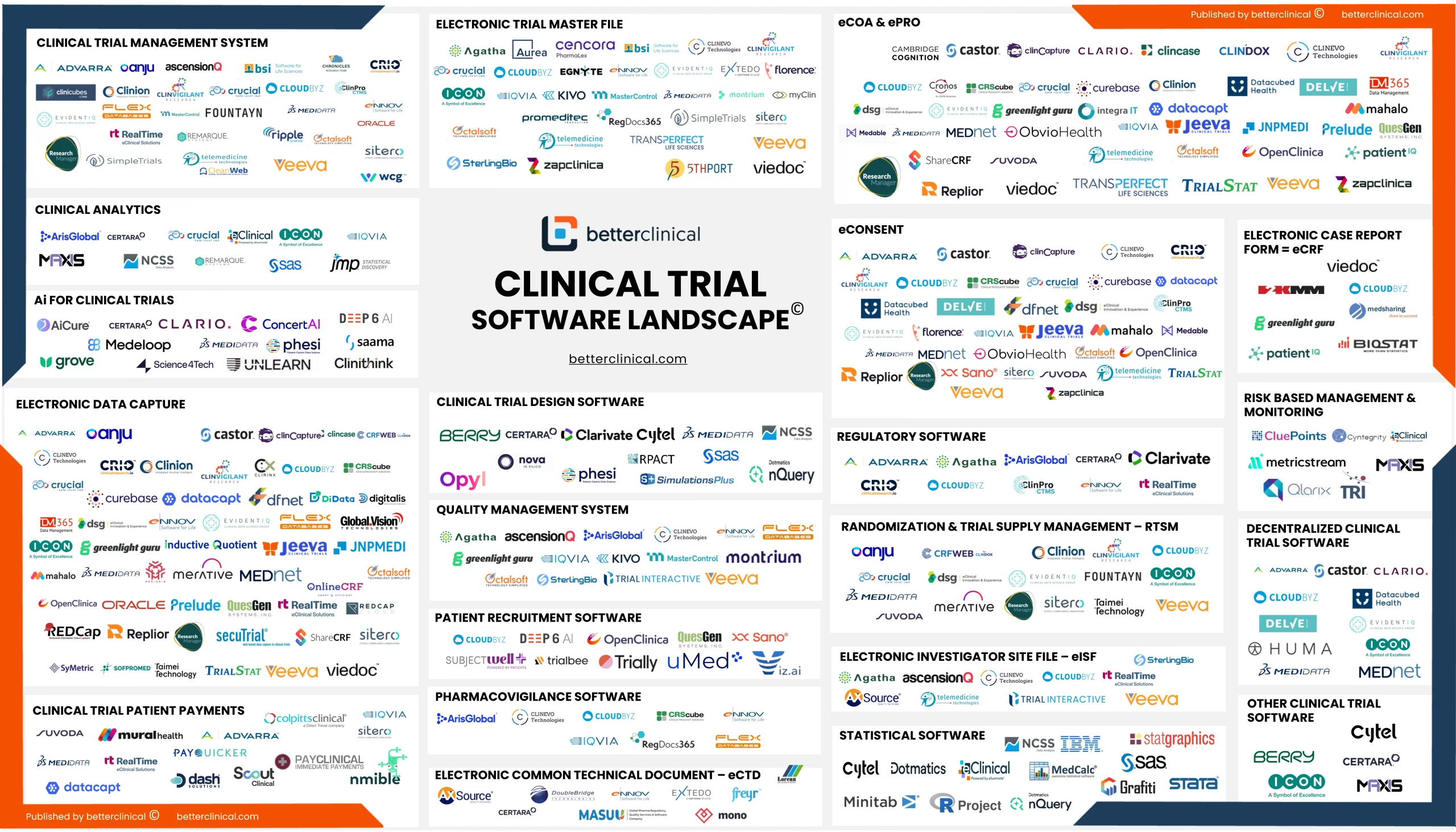
The Clinical Trial Software Landscape
Review a comprehensive look at the clinical trial software vendor ecosystem, in infographic format

